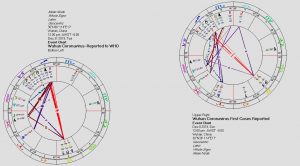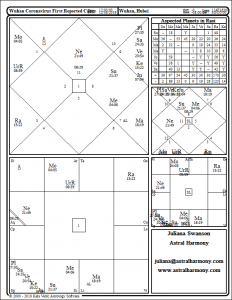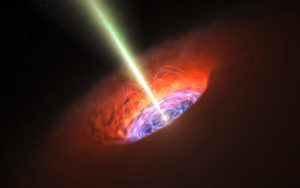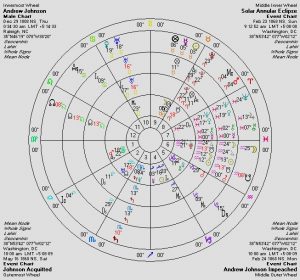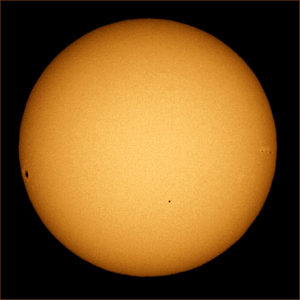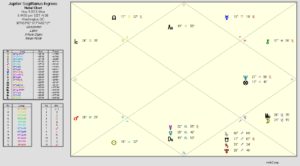As I write this, “equinox cracks” are opening in the Earth’s magnetic field as the northern autumnal equinox is a week away. These cracks or fissures which typically form in Earth’s magnetosphere around the autumnal equinox allow solar wind to penetrate and create bright displays of the Aurora Borealis or Northern Lights. The equinox will occur on Monday, September 23 at 3:50 AM Eastern Time (7:50 AM UTC). In the northern hemisphere, it will be autumnal equinox, and in the southern hemisphere, it will be spring.
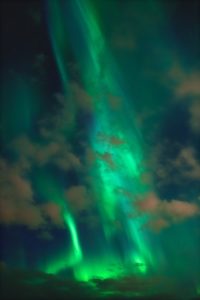 From the Latin “aequus”/equal and “nox”/night, the equinox occurs when the Sun in its apparent path along the ecliptic crosses the celestial equator, and day and night are of equal length all across the earth. The fall and spring equinoxes mark seasonal cycles as well as cycles within the human energetic system. The two are very much connected, “As Above, So Below; As Within, So Without.”
From the Latin “aequus”/equal and “nox”/night, the equinox occurs when the Sun in its apparent path along the ecliptic crosses the celestial equator, and day and night are of equal length all across the earth. The fall and spring equinoxes mark seasonal cycles as well as cycles within the human energetic system. The two are very much connected, “As Above, So Below; As Within, So Without.”
 The Earth has an electromagnetic field separated by the equator into the northern and southern hemispheres. The magnetic flow of the northern hemisphere moves clockwise, and that of the southern hemisphere moves counterclockwise. The terrestrial equator projected out onto the celestial equator forms a band of zero magnetism. On the equinoxes, the Sun passes over this zero field, creating a still point in which the Earth’s magnetic energies reach their lowest ebb, at which time the entire Earth becomes intensely bathed in higher astral (spiritual or cosmic) forces. This period of increased etheric radiation extends from the day before to the day after the equinox, so for about 48 hours total.
The Earth has an electromagnetic field separated by the equator into the northern and southern hemispheres. The magnetic flow of the northern hemisphere moves clockwise, and that of the southern hemisphere moves counterclockwise. The terrestrial equator projected out onto the celestial equator forms a band of zero magnetism. On the equinoxes, the Sun passes over this zero field, creating a still point in which the Earth’s magnetic energies reach their lowest ebb, at which time the entire Earth becomes intensely bathed in higher astral (spiritual or cosmic) forces. This period of increased etheric radiation extends from the day before to the day after the equinox, so for about 48 hours total.
 The equinoxes (as well as solstices and monthly sun sign ingresses) are known as sankrantis in Vedic astrology. Because the sankrantis represent the Sun’s transitional energy, classical Muhurta (elective astrology) considers it a “dosha” or detriment to begin anything that should be of lasting importance within three days before and after the ayanas (solstices), and within one day either side of the visuvas (equinoxes). In regard to this upcoming equinox, we should avoid beginning anything new or setting anything important into motion (like an important communication, trip, job, new home, business, relationship, or medical procedure, etc.) starting at 3:50 AM Eastern Time/7:50 UTC on September 22 until 3:50 AM Eastern Time/7:50 AM UTC on September 24). Whatever is begun at these times may not give the expected result, or may not be brought to a healthy conclusion or give a successful long term result. However, equinoxes and solstices are wonderful times for introspective practices and spiritual ceremonies.
The equinoxes (as well as solstices and monthly sun sign ingresses) are known as sankrantis in Vedic astrology. Because the sankrantis represent the Sun’s transitional energy, classical Muhurta (elective astrology) considers it a “dosha” or detriment to begin anything that should be of lasting importance within three days before and after the ayanas (solstices), and within one day either side of the visuvas (equinoxes). In regard to this upcoming equinox, we should avoid beginning anything new or setting anything important into motion (like an important communication, trip, job, new home, business, relationship, or medical procedure, etc.) starting at 3:50 AM Eastern Time/7:50 UTC on September 22 until 3:50 AM Eastern Time/7:50 AM UTC on September 24). Whatever is begun at these times may not give the expected result, or may not be brought to a healthy conclusion or give a successful long term result. However, equinoxes and solstices are wonderful times for introspective practices and spiritual ceremonies.
The time around the fall equinox marks a turning point, a time of rebalancing, rebirth, and inner or outer change, when not only the Earth herself but also each one of us goes through an electromagnetic adjustment as we begin to turn more inward. (Of course this is the opposite in the southern hemisphere). The fall equinox has long been celebrated as a time of annual renewal by most of the world’s spiritual traditions. As the natural world (in the northern hemisphere where I live) begins to let go and draw within, so are we asked to take time for inner reflection and healing in order to restore balance to our lives as we prepare for the colder introspective “yin” seasons of the year.
The energy of the fall season is all about “letting go and letting God.” This is because the element associated with fall is ether (akash), the prime latent elemental force that endlessly flows directly from Divine Source through all of creation. Ether is associated with the element “metal” in the Chinese Five-Element system, and is associated with the vata dosha (and vata season) according to Ayurveda (vata = air + ether elements). According to Dr. Randolph Stone, creator of Polarity Therapy, the ether element is “the river from which all other rivers [elements] flow.” In the fall season, nature gives us an opportunity to deeply reconnect with this ultimate source of our power.
The basic qualities of balanced ether are spaciousness, tranquility, humility, and acceptance. Ether can evoke feelings of grief and contraction when it is imbalanced or obstructed. In other words, we experience the sorrow of loss and a sense of meaninglessness when we are disconnected from Source. By allowing ourselves the space to grieve and mourn our losses, we can bring balance.
 In addition, the ether element flows more freely within us when we remain fully grounded in the present moment; when we acknowledge and speak our truth; and, when we align our willpower with a higher meaning and purpose. The part of ourselves that is beyond form and flux is revealed through the ether element. Through a regular practice of meditation, inner stillness and listening, we can open the channel of ether and access a profound sense of inner calm during this season.
In addition, the ether element flows more freely within us when we remain fully grounded in the present moment; when we acknowledge and speak our truth; and, when we align our willpower with a higher meaning and purpose. The part of ourselves that is beyond form and flux is revealed through the ether element. Through a regular practice of meditation, inner stillness and listening, we can open the channel of ether and access a profound sense of inner calm during this season.
Stepping down through the higher chakras, the ether element is seated in the throat chakra, where it influences the thyroid gland (metabolism) and is associated with willpower; communication; creativity; truthfulness; and, integrity. From the throat center, ether concentrates in the cerebrospinal fluid, and then moves out into the lymphatic system, and then, into the synovial fluid of the joints.
 As many parts of our bodies are full of space, ether is everywhere besides just in the joints, cerebrospinal and lymphatic fluids; it is in the ears (and thus relates to hearing); all the intracellular and extracellular spaces; sinus and nasal passages; the lungs; mouth, stomach and intestines; uterus; bladder; and, kidney spaces. With so many bodily systems and networks being activated in the season of ether, it becomes more clear that the autumnal change of season has a powerful effect on our health and well-being, which is why we need to be mindful and take good care. To that effect, here’s a link to a great Yoga Digest article with important tips on how to Nurture Vata (Autumn Season) Gracefully. (In many areas, Vata season tends to run from late September through February, but this differs a bit according to different geographical climate zones).
As many parts of our bodies are full of space, ether is everywhere besides just in the joints, cerebrospinal and lymphatic fluids; it is in the ears (and thus relates to hearing); all the intracellular and extracellular spaces; sinus and nasal passages; the lungs; mouth, stomach and intestines; uterus; bladder; and, kidney spaces. With so many bodily systems and networks being activated in the season of ether, it becomes more clear that the autumnal change of season has a powerful effect on our health and well-being, which is why we need to be mindful and take good care. To that effect, here’s a link to a great Yoga Digest article with important tips on how to Nurture Vata (Autumn Season) Gracefully. (In many areas, Vata season tends to run from late September through February, but this differs a bit according to different geographical climate zones).

As the equinox looms, there’s a sense of intensity “in the air,” so it’s important to be aware as our bodies and minds are more vulnerable than usual. In addition, Saturn, the Lord of Karma, is stationing direct on September 18 after having been retrograde since late April. His stationary period is felt for five days before and after the station. For some, it can feel like a relief valve opening up so that something(s) in our lives may soon start to break free and and move forward. In the Vedic calendar, we are also in the Pitru Paksha season from September 13-28, the time for honoring the ancestors. When this two-week period comes to a close, Sharad (Ashwin) Navaratri will begin, the most important nine-night Mother Divine festival of the year which is set aside for worshiping and celebrating Devi Durga Mata and asking for her blessings.
Happy Equinox, with love and light from Juliana!

 This is the autumnal equinox in the southern hemisphere, but since I live in the northern half of the world, I mainly focus on the vernal equinox in this article. That said, both vernal and autumnal equinoxes universally represent a time when the earth energies as well as our own bio-energetic systems are dramatically shifting gears, so our emotional and physical health can be quite sensitive, and we need extra rest and care to protect our life force and to help us stay steady.
This is the autumnal equinox in the southern hemisphere, but since I live in the northern half of the world, I mainly focus on the vernal equinox in this article. That said, both vernal and autumnal equinoxes universally represent a time when the earth energies as well as our own bio-energetic systems are dramatically shifting gears, so our emotional and physical health can be quite sensitive, and we need extra rest and care to protect our life force and to help us stay steady.

